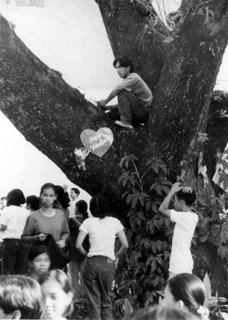 Remember the 1990’s movie “Jerry Maguire” starring Tom Cruise and Cuba (Show me the money!) Gooding Jr.? After Tom’s character gets fired from the sports management company, he desperately tries to convince other employees to come along with him to form another company. But, besides the goldfish, the only one who responds to his call is the lovestruck accountant, played by the absolutely! gorgeous! Reneé Zellwegger! (If National Artist for Literature José Garcia Villa had his “comma, comma” poems, I also have my own “exclamation point poetic device,” okay?) Anyway, what did Tom Cruise say? “This could be the start of something fun!”
Remember the 1990’s movie “Jerry Maguire” starring Tom Cruise and Cuba (Show me the money!) Gooding Jr.? After Tom’s character gets fired from the sports management company, he desperately tries to convince other employees to come along with him to form another company. But, besides the goldfish, the only one who responds to his call is the lovestruck accountant, played by the absolutely! gorgeous! Reneé Zellwegger! (If National Artist for Literature José Garcia Villa had his “comma, comma” poems, I also have my own “exclamation point poetic device,” okay?) Anyway, what did Tom Cruise say? “This could be the start of something fun!”
 |
| Free street photography e-books by Thomas Leuthard: Going Candid - An unorthodox approach to Street Photography Collecting Souls - What Street Photography means to me Street Faces – The Art of Candid Street Portraiture |
Photography is indeed a hobby to a lot of people, but it is also a bread and butter profession for others, a lifelong pursuit for some, and a deliberately chosen means of self-expression for a very few. Whatever photography may be to you, certain sacrifices have to be made if you want to excel in this art, or in any art form, for that matter. N.V.M. Gonzales, a literary giant among Filipinos (my favorite among his stories is “Blue Skull and Dark Palms”), during his teenaged years, walked five kilometers a day in getting to and from the town hall that had the only typewriter in that place. Talk about dedication and sacrifice!
But “expensive” need not be the word to describe photography. You can always use “re-loaded” film, which costs less than the regular films. Or, you can hone your skills by volunteering to take pictures of birthdays or programs where other people naturally would have to shoulder the expenses. Of course, with the advent of digital photography, there’s no need to even buy film. You just have to shoot your pictures, download your images through your computer’s USB cable, and you’re ready to shoot again!
In terms of SLR cameras, you can find relatively inexpensive manual camera models on the market. Or you can choose to buy a second hand camera ... Me, I really started learning about photography by borrowing the camera of my staffer, but you already know the story from the Introduction to this series, right? Right!
Photography is an art form that is accessible for all. You don’t need formal studies in order to be a good photographer. As Ernst Haas said, “If art is aristocratic, then photography is its democratic voice.” This statement however is not meant to disparage photography as an art form. (“Disparage” - I love these high sounding words!) Anyone can learn photography but not everyone can be a good photographer. There aren’t that many Vic Valencianos, Lita Puyats, Mandy Navaseros,Toch Arellanos, Vic Sisons, or Ed Santiagos, among us, you know!
 The best way to improve yourself as a photographer is to show your pictures to people whose opinion you respect like your teachers, classmates, or the pizza delivery guy! These people, if they’re honest enough, will tell you not only what’s good but more importantly, what’s bad with the photographs you have taken. Avoid people who only say good things about your pictures; they probably just want to borrow money from you! Wig Tysman, a well-known fashion photographer, once said that his best critic is his wife who would lovingly ask him over breakfast, “Were you sane when you took this picture?” She’s my kind of woman!
The best way to improve yourself as a photographer is to show your pictures to people whose opinion you respect like your teachers, classmates, or the pizza delivery guy! These people, if they’re honest enough, will tell you not only what’s good but more importantly, what’s bad with the photographs you have taken. Avoid people who only say good things about your pictures; they probably just want to borrow money from you! Wig Tysman, a well-known fashion photographer, once said that his best critic is his wife who would lovingly ask him over breakfast, “Were you sane when you took this picture?” She’s my kind of woman!Richard Avedon, circa 1996, is the most influential photographer in the world, ranking number one in an American Photo survey of the 100 most important people in photography. By the way, model Kate Moss, along with other super models like Cindy Crawford, was ranked number 82 in that survey! Anyway, not very many people know that Avedon learned about photography when, as a merchant marine at age 19, he was given the job of shooting ID pictures. Avedon, in the book Evidence 1944-1994, stated, “I must have taken pictures of maybe one hundred thousand baffled faces before it occurred to me I was becoming a photographer.” From IDs to fashion and portraits - way to go, Mr. Avedon!
Sebastião Salgado, an economist considered as the world’s best photojournalist, practically didn’t know anything about photography until his wife, Leila, an architect, gave him a camera as a gift. The first time he looked through the viewfinder, however, Salgado was hooked on photography! Boy, I wish I had a wife who will give me a camera! I mean, I mean, I mean, I mean, boy, I wish I had a wife!
By whatever way you fall in love with photography, OR if you do have the talent for it, use it, nurture it, share it! Starting now! As Julia Roberts’s best friend in the movie “My Best Friend’s Wedding” says, “If you really love someone, you’ve got to say it, out loud! Otherwise, the moment will just pass you by.” Me, as I mentioned in the Introduction to this series, I fell in love with photography when I fell in love with a beautiful actress named, what’s her name again? Beth Tamayo? No, already spoken for! Sandra Bullock? No, too intense! Ally Macbeal? No, too weird! Buffy, the really cute Vampire Slayer? No, no, too violent! Julia Roberts? Wow! Cameron Diaz? Wow! Oh, yes, now I remember, Murphy Brown! Yes!
A spark of the divine fire
Martha Foley’s short story “One With Shakespeare” chronicles a young girl’s exquisite discovery of her talent for writing. Through the encouragement of her high school teacher, the girl realizes that just like Shakespeare, she also had that creative potential, that “spark of the divine fire.” She begins to savor the emotions, the expressions, the ideas her words could bring forth. She begins to learn how to create memorable images in the mind’s eye through words. Looking out the windows of the library, she sees the flower filled trellis and her mind is filled with images of “black sentinels against the sky.”
Perhaps your talent isn’t in photography but in creative writing or journalism. But this series on photojournalism can still help you through an activity known as “writing through seeing.” Sometimes, you run out of ideas or topics to write about. What you can do is to look at the pictures in this series, and use them as your inspiration, as starting points for writing descriptions, narration, expositions, dialogues, short stories, etc.

 For example, you can write a description of your feelings as you look at the solitary branch against the sunset above. Write about the glorious sunsets in Boracay when you went there last summer. Write about how you felt, what you thought about as you and your family spent time together along Baywalk. Write about how you felt getting turned down for the tenth time by the same girl (ouch!)
For example, you can write a description of your feelings as you look at the solitary branch against the sunset above. Write about the glorious sunsets in Boracay when you went there last summer. Write about how you felt, what you thought about as you and your family spent time together along Baywalk. Write about how you felt getting turned down for the tenth time by the same girl (ouch!) You can use the picture above of the guy up on a tree to learn how to write dialogue; notice that the girl with a white T-shirt is looking up at the guy, and there’s a heart-shaped piece of paper with the words “Happy Valentine” on the tree.
You can use the picture above of the guy up on a tree to learn how to write dialogue; notice that the girl with a white T-shirt is looking up at the guy, and there’s a heart-shaped piece of paper with the words “Happy Valentine” on the tree.In my 12 years of teaching, two of the best student writers I ever had the pleasure of teaching were Mylah Reyes-Roque (from Rizal High School in Pasig, Class ’87; she recently won a UNICEF award for her Newsbreak magazine article on child prisoners), and Cyrille Cucio from Quezon City Science High School Class ‘84. But Cyrille went into medicine rather than journalism or creative writing. (She is now working in a New York City hospital.) When we met several years after high school, I told Cyrille that I was disappointed with her because she wasted her talent for writing. Well, writing’s loss is medicine’s gain, I suppose... or she could be the next Arturo B. Rotor of Philippine literature! In case you’ve forgotten, Rotor, a medical doctor, wrote the classic short story “Zita.”
Whatever your talent may be, nurture it, share it. That talent, that "spark of the divine fire" is a gift from God.






No comments:
Post a Comment